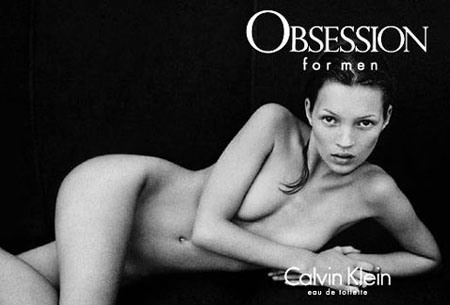Throughout our class
readings and discussions, I have a greater understanding that media images are
developed and circulated quite deliberately, with the intent of eliciting a
specific response from media consumers. In the case of advertising, ads are
tailored to a target demographic, promoting unrealistic standards of beauty,
health, or wealth. Ads have a tendency to romanticize forbidden desires or make
promises as a result of buying their products (such as perfume ads and their
blatant sexual themes). Apart from this, popular advertisements grossly
underrepresent those of different races and sexual identities, and critically
misrepresent the female gender.
| Sean John perfume ad depicting a submissive woman, a forbidden desire |
The biggest problem with
this? The advertising industry is undoubtedly the most pervasive in modern
society. Whether it’s in film, television, newspapers, magazines, or even on
phone applications, everyone is subject to this kind of exposure. Not all ads
use “draping blondes in evening gowns over the hoods like ornaments,” nor are
they all “sadistic, he-man campaigns,” but they are all delivered with the
intent of selling something to the media consumer (Steinem 113). As
stated by Douglas Kellner in “Reading Images Critically,” advertisers keep in
mind “images not only to attempt to sell a product by associating it with
certain socially desirable qualities, but they sell as well a worldview, a
lifestyle, and a value system congruent with the imperatives of consumer
capitalism” in the creation of ads (Kellner 127). And what happens when someone
doesn’t fill these predetermined, “socially desirable qualities”? They are
shunned, shunned by society for any departure from “normalcy”.
In most advertising, the
depiction of women is typically as sex object. Besides taking on a submissive
role, she is given no form of personality traits relative to the man who
usually accompanies her in the ad. The woman as a “sex object is a mannequin, a
shell. Conventional beauty is her only attribute” (Kilbourne 122). As John Berger
states, the “man’s presence [in the image] is dependent upon the promise of
power which he embodies” (Berger 45). While satisfying the male gaze,
advertisements such as these only exacerbate patriarchal ways of thinking.
AXE Body Spray "Beach" commerical depicting the "mannequin" sex object
These ads dictate to
both men and women what it means to be feminine, and women and girls are
expected to “be overtly sexy and attractive but essentially passive and
virginal”, adding overbearing pressures on them which in turn leads to problems
like eating disorders and depression, just to name a few (Kilbourne 130).
| Ad for "Stop the beauty madness" social change campaign |
These targeted ads have
far-reaching effects that speak to racist ideologies as well. The “ideal” women
presented in these ads all have similar traits: their “preferred look is
younger, slender, sexual, and white” (Wykes/Gunter 266). As bell hooks states,
this simply promotes the “imperialist white-supremacist capitalist patriarchy”
(hooks 17). This underrepresentation of non-white persons creates serious
psychological implications. Society dictates that to be attractive, to be
successful, one must fulfill each of these traits. As a result of this lack of
diversity in advertising, non-white women and girls are being taught from a
young age that their self-worth is determined by factors beyond their control.
They feel insecure on the lack of representation, and try to change themselves
in order to fit the societal construct of beauty. As bell hooks states, mastery
of the oppositional gaze is critical for combating this.
 |
| Beauty defined as younger, slender, sexual, and white |
Being undoubtedly
society's most influential medium up to this point, it is unlikely that
advertising will ever lose its grasp on the minds of people. While its place is
secured in popular media, however, mentalities of media consumers are rapidly
changing. We no longer live in the traditionally patriarchal society of our
elders, contrary to what advertisements might try to convey. In order to remain
most effective, advertisements must reflect and engage our current society.
There is now a calling
for reflections of feminist ways of thinking, where advertisements don’t need
to objectify women in order to sell clothing or perfumes. Modern advertisements
such as that of simple commercials on television can make greater impressions
by showing interracial couples, gay couples, or both as a reflection of a current,
realistic society.
The advertising industry
isn’t going anywhere. But the best way to change how the industry chooses to
market goods and services is by collectively boycotting those that
misrepresent, or even neglect, modern ways of thinking. They key to revamping
the advertising industry is to show a more positive, and realistic portrayal of
gender, race, and sexuality. Realistic depictions and genuine representations
of diversity go a long way. New ads that include those who are underrepresented
(i.e. those who aren’t just white and heterosexual with two kids, a house, and
a golden retriever) will be more effective in a consumer culture that values
realistic standards over unattainable ones used to sell products. With
technology only further integrating advertisement media in our lives, it’s on the
media consumers to discuss improving ads with advertisers, as Gloria Steinem
referred to in regards to Ms.
magazine in Sex, Lies, and Advertising.
Works Cited
John Berger “Ways of Seeing”
Bell Hooks “Understanding
Patriarchy”
Douglas Kellner “Reading
Images Critically”
Jean Kilbourne “The
More You Subtract The More You Add”
Gloria Steinem “Sex,
Lies, and Advertising”
Maggie Wykes & Barrie Gunter “The Media and Body Image”
No comments:
Post a Comment